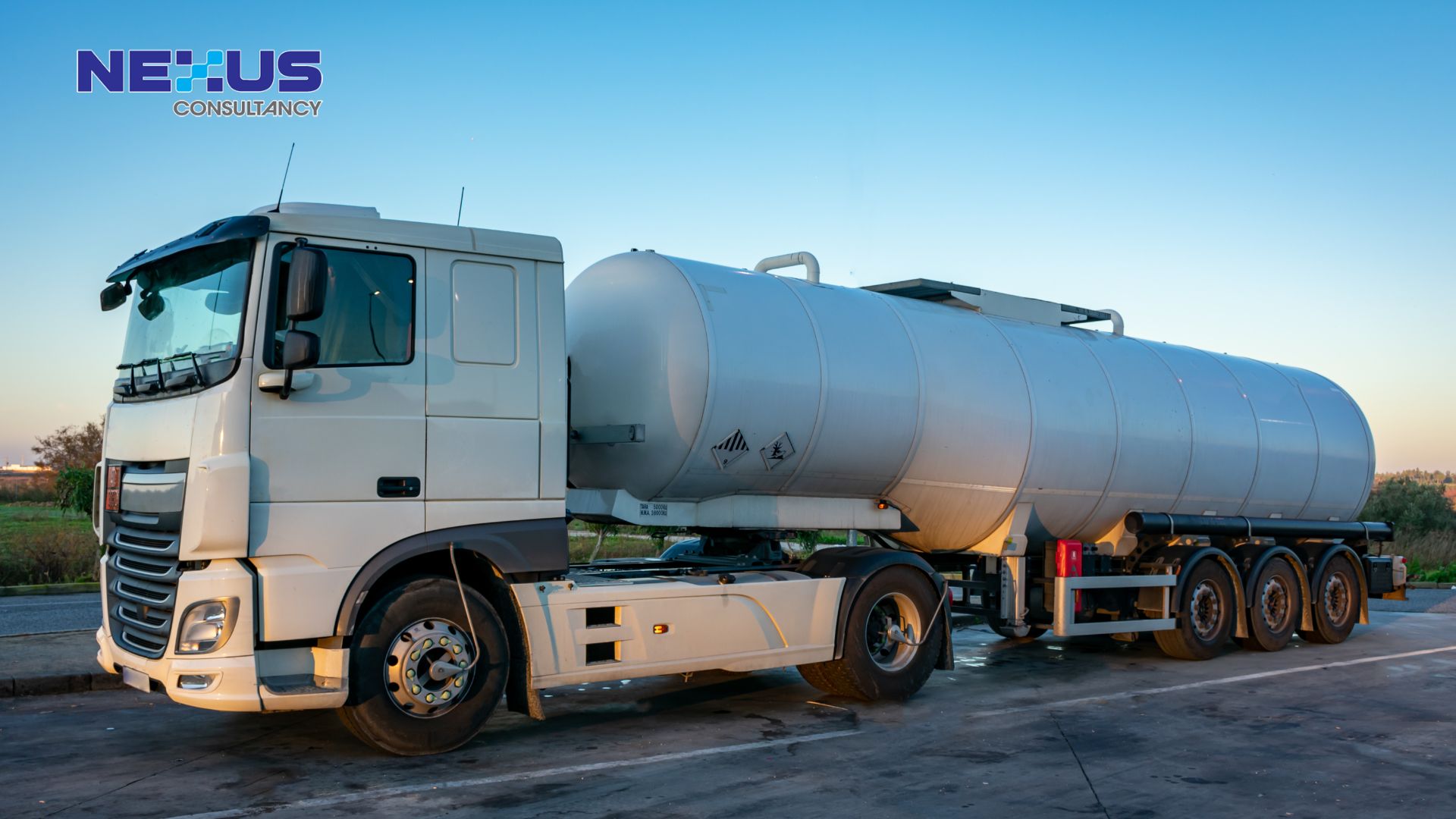
Danielle Tan
Chief Operating Officer
Learn key hygiene protocols, effective cleaning methods, and compliance tips for maintaining safe and contamination-free food products.

In the global food supply chain, ensuring food safety is paramount, especially when transporting foodstuffs in bulk. Transporting unpackaged food products exposes them to the risk of contamination, making the cleanliness of transport tanks a critical control point in maintaining food safety standards. This is especially vital for industries dealing with liquid or semi-liquid food items like oils, juices, and dairy products. Poor tank cleaning practices can lead to cross-contamination, foodborne illnesses, and compromised product quality, thereby posing significant risks to public health and business reputations. In this article, we explore the best practices for transport tank cleaning, guided by the latest food safety management standards, including ISO 22000:2018 and ISO/TS 22002-5:2019.
While ISO standards provide the framework, organizations need to actively foster a culture of continuous improvement by using strategies that align with ISO principles. Here are some practical approaches:
The Importance of Transport Tank Cleaning
Foodstuffs transported in bulk are particularly vulnerable to contamination, as they come into direct contact with the transport tank surfaces. If a tank is inadequately cleaned after a previous load, residues can mix with the current cargo, causing cross-contamination. In some cases, these residues might introduce allergens, chemical contaminants, or microbiological hazards, all of which can pose severe food safety risks.
Additionally, visual inspections alone are insufficient for assessing the cleanliness of a transport tank. Microbiological contaminants, allergens, or chemical residues are not always visible to the naked eye. Hence, strict cleaning protocols are necessary to ensure that tanks are free of any contaminants before loading a new food product.
Understanding the Risks: Cross-Contamination and Allergens
One of the key risks in food transport is cross-contamination, where residues from previous cargo mix with the current food product. This risk is amplified when allergenic substances are involved. For instance, a transport tank previously used for carrying a liquid containing peanuts must be thoroughly cleaned before being used to carry a non-allergenic product like juice. Any residual traces of peanuts could trigger allergic reactions in consumers.
Inadequate cleaning can also lead to contamination with harmful microorganisms such as Salmonella, Listeria, or E. coli, which thrive in moist environments. Given that tanks often transport liquids, the risk of microbial contamination is significant. Thorough cleaning and disinfection of tanks between loads are essential to mitigate these risks.
Best Practices for Transport Tank Cleaning
The process of transport tank cleaning must be systematic, risk-based, and aligned with internationally recognized food safety standards. The following best practices, derived from the ISO 22000:2018 standard and the ISO/TS 22002-5:2019 guidelines, provide a robust framework for ensuring that transport tanks are properly cleaned and maintained.
- Cleaning Methods: Cleaning-in-Place (CIP) vs. Cleaning-out-of-Place (COP)
Transport tanks can be cleaned using two primary methods: Cleaning-in-Place (CIP) and Cleaning-out-of-Place (COP). In CIP, tanks are cleaned without being dismantled, usually by circulating cleaning solutions through the tank. This method is efficient and commonly used for tanks that handle liquid foodstuffs. On the other hand, COP involves disassembling parts of the tank and cleaning them manually or in a separate cleaning system.
Both methods are effective when applied correctly, but the choice depends on the type of food product, the tank design, and the level of contamination. High-pressure cleaning with spinners and spray heads is often used in external commercial cleaning stations to ensure thorough cleaning.
- Cleaning Validation and Verification
One of the critical aspects of ensuring transport tank cleanliness is the validation and verification of cleaning processes. Cleaning validation confirms that the chosen cleaning protocols effectively eliminate potential hazards, including microbiological, chemical, and allergenic contaminants. This process often involves microbiological testing, particularly in high-risk situations where contamination can have serious consequences.
Verification involves regular checks to ensure that cleaning protocols are consistently applied. According to ISO 22000:2018, cleaning certificates alone are not sufficient for verification. Full traceability of the cleaning process is essential, including documentation of the cleaning methods used, the prior cargo, and the results of cleanliness assessments.

- Control Measures and Risk Assessment
Organizations must implement a documented, risk-based plan for transport tank cleaning. This plan should identify potential sources of contamination and define appropriate control measures to mitigate these risks. For example, tanks that transport allergenic products must have specific cleaning protocols in place to prevent cross-contact.
Risk assessment should consider the type of food product, the tank’s cleaning history, and the tank’s exposure to external factors. Additionally, regular inspections and audits of cleaning stations are necessary to ensure compliance with food safety standards.
- Training and Competency of Personnel
Ensuring that personnel involved in the cleaning process are adequately trained is crucial. Drivers, loading/unloading staff, and cleaning station personnel must be aware of the risks associated with improper tank cleaning. The organization should establish a team of experts responsible for overseeing transport tank cleaning as part of the food safety management system.
Training should cover the correct use of cleaning equipment, the importance of cleaning validation, and procedures for verifying cleanliness before loading foodstuffs into the tank. Internal auditors must also be trained to assess the effectiveness of cleaning processes during audits.
- Supplier Agreements and External Cleaning Stations
Many food companies outsource transport tank cleaning to external cleaning stations. In such cases, supplier agreements play a vital role in ensuring that cleaning standards are met. These agreements should outline the cleaning requirements, including cleaning validation, the disclosure of prior cargo, and the verification of cleaning between loads.
Companies must regularly audit their cleaning service providers to verify that agreed-upon cleaning protocols are followed. Maintaining a list of approved cleaning stations and subcontractors is essential to ensure that all service providers meet the required food safety standards.

Conclusion
Transport tank cleaning is a critical component of food safety management in bulk transport. Inadequate cleaning practices can lead to cross-contamination, compromising product safety and quality. By implementing best practices such as cleaning validation, risk assessment, and thorough training of personnel, organizations can ensure that their transport tanks are clean and safe for foodstuffs. Adherence to international standards like ISO 22000:2018 and ISO/TS 22002-5:2019 further strengthens food safety management, helping businesses protect consumers and maintain regulatory compliance in a complex global food supply chain.
Reference:
- Food Safety System Certification 22000 Guidance Document: Transport Tank Cleaning.
- ISO 22000:2018 Food Safety Management Systems- Requirements for Any Organization in the Food Chain.
- ISO/TS 22005-1:2019 Prerequisite Programs on Food Safety Part 5: Transport and Storage.
Curious to learn how your organization can ensure Food Safety in Bulk Transport? Get in touch with us now for more information.






